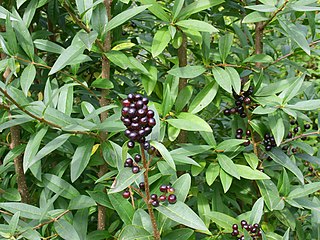
Morus, a genus of flowering plants in the family Moraceae, comprises 10–16 species of deciduous trees commonly known as mulberries, growing wild and under cultivation in many temperate world regions.

Hornbeams are hardwood trees in the flowering plant genus Carpinus in the birch family Betulaceae. The 30–40 species occur across much of the temperate regions of the Northern Hemisphere.

A privet is a flowering plant in the genus Ligustrum. The genus contains about 50 species of erect, deciduous or evergreen shrubs, sometimes forming small or medium-sized trees, native to Europe, north Africa, Asia, many introduced and naturalised in Australasia, where only one species extends as a native into Queensland. Some species have become widely naturalized or invasive where introduced. Privet was originally the name for the European semi-evergreen shrub Ligustrum vulgare, and later also for the more reliably evergreen Ligustrum ovalifolium used extensively for privacy hedging, though now the name is applied to all members of the genus. The generic name was applied by Pliny the Elder to L. vulgare. It is often suggested that the name privet is related to private, but the OED states that there is no evidence to support this.

Vaccinium uliginosum is a Eurasian and North American flowering plant in the genus Vaccinium within the heath family.

Cupressus torulosa, commonly known as the Himalayan cypress or Bhutan cypress, is a species of cypress tree native to South Asia.

Quercus mongolica, commonly known as Mongolian oak, is a species of oak native to Japan, southern Kuriles, Sakhalin, Manchuria, central and northern China, Korea, eastern Mongolia, and eastern Siberia. The species can grow to be 30 m tall.
Vitis mengziensis is a species of plant in the grape family. It is found in the province of Yunnan in China, where it is known by the name meng zi pu tao, meaning Mengzi or Mengtze grape. The specific epithet mengziensis and vernacular Chinese name refer to Mengzi, a county in the southeast of Yunnan. It grows in temperate rainforests, at elevations near 1600 meters.
Vitis hui is a species of plant in the grape family. It is native to Jiangxi and Zhejiang provinces in China, where it is called lu shan pu tao, meaning Mount Lushan grape. It grows in temperate climes, at elevations between 100–200 meters in shrublands and along the edges of open meadows.
Vitis balansana is a species of climbing vine in the grape family native to temperate and tropical Asia. Its native range encompasses Vietnam and three southeastern provinces in China The habitat of V. balansana varies; it has adapted to living under forest cover, and in sun-soaked shrubland valleys, at between 200–800 meters.
Vitis ruyuanensis is a species of polygamo-dioecious plant in the grape family native to the Chinese province of Guangdong. Here it grows in shrublands or along hillsides at around 200 meters. Flowers, blooming between April and May, give way to the development of globular berries in June and July.
Vitis betulifolia is a widely ranging species of liana in the grape family native to China where its habitat is forested or shrubby valleys and hillsides, at elevations from 600 to 3,600 metres.
Vitis sinocinerea is a species of climbing vine in the grape family ranging widely over much of the Chinese mainland as well as Taiwan. In Chinese
it is known as xiao ye pu tao, which can be translated as small-leaved grape. Its natural habitat is within forested or shrubby hills.
Vitis menghaiensis is a species of climbing vine in the grape family native to China. It is found in mixed forests around 1500–1600 meters above sea-level. It flowers in May, and male flowers have non-functioning ovaries.
Vitis bryoniifolia is a prolific and adaptable, polygamo-dioecious species of climbing vine in the grape family native to China, where it is known as ying yu, or hua bei pu tao. The variant form ternata is known as san chu ying yu, meaning three-foliolate, or -leaflet ying yu. Ying yu translates to mean "hard jade".
Vitis heyneana is a species of climbing vine in the grape family endemic to Asia. It can be found in shrubby or forested areas, from almost sea-level, to 3200 meters above. It has globose berries that are purple to almost black.

Indochina, originally Indo-China, is a geographical term which originated in the early nineteenth century and refers to the region today known as Mainland Southeast Asia, or the Indochinese Peninsula. The name refers to lands historically within the cultural influence of India and China, and physically bound by the Indian Subcontinent in the west and China in the north. It corresponds to the present-day areas of Cambodia, Thailand, Laos, Myanmar, Vietnam, and (variably) peninsular Malaysia and Singapore. The term was later adopted as the name of the colony of French Indochina.







